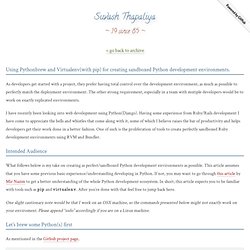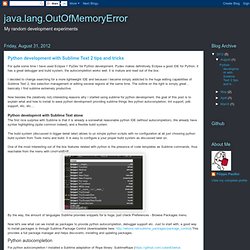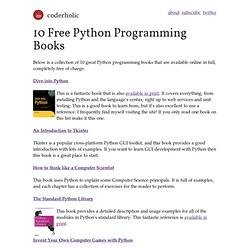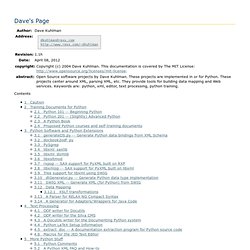Online materials
> Software engineering
> Python
Python Websites and Tutorials. The Hitchhiker’s Guide to Python!
Greetings, Earthling!

Welcome to The Hitchhiker’s Guide to Python. This is a living, breathing guide. If you’d like to contribute, fork us on GitHub! This handcrafted guide exists to provide both novice and expert Python developers a best practice handbook to the installation, configuration, and usage of Python on a daily basis. This guide is opinionated in a way that is almost, but not quite, entirely unlike Python’s official documentation. Note The use of Python 3 is highly preferred over Python 2. Let’s get started!
Using Pythonbrew and Virtualenv(with pip) for creating sandboxed Python development environments.
Using Pythonbrew and Virtualenv(with pip) for creating sandboxed Python development environments.

As developers get started with a project, they prefer having total control over the development environment, as much as possible to perfectly match the deployment environment. The other strong requirement, especially in a team with mutiple developers would be to work on exactly replicated environments. I have recently been looking into web development using Python(Django). Having some experience from Ruby/Rails development I have come to appreciate the bells and whistles that come along with it, some of which I believe raises the bar of productivity and helps developers get their work done in a better fashion.
One of such is the proliferation of tools to create perfectly sandboxed Ruby development environments using RVM and Bundler. Intended Audience What follows below is my take on creating as perfect/sandboxed Python development environments as possible.
Python Module of the Week. Python development with Sublime Text 2 tips and tricks. For quite some time I have used Eclipse + PyDev for Python development.

Pydev makes definitively Eclipse a good IDE for Python, it has a great debugger and build system, the autocompletion works well, it is mature and read out of the box. I decided to change searching for a more lightweight IDE and because I became simply addicted to the huge editing capabilities of Sublime Text 2, like selection management or editing several regions at the same time. The outline on the right is simply great... basically I find sublime extremely productive. Now besides the (relatively not) interesting reasons why I started using sublime for python development, the goal of this post is to explain what and how to install to ease python development providing sublime things like python autocompletion, lint support, pdb support, etc, etc....
How to use Jenkins for python development. 10 Free Python Programming Books. Below is a collection of 10 great Python programming books that are available online in full, completely free of charge: Dive into Python This is a fantastic book that is also available in print .

It covers everything, from installing Python and the language's syntax, right up to web services and unit testing.
Python Programming for Beginners. Despite what assembly code and C coders might tell us, high-level languages do have their place in every programmer's toolbox, and some of them are much more than a computer-science curiosity.

Out of the many high-level languages we can choose from today, Python seems to be the most interesting for those who want to learn something new and do real work at the same time. Its no-nonsense implementation of object-oriented programming and its clean and easy-to-understand syntax make it a language that is fun to learn and use, which is not something we can say about most other languages. In this tutorial, you will learn how to write applications that use command-line options, read and write to pipes, access environment variables, handle interrupts, read from and write to files, create temporary files and write to system logs. In other words, you will find recipes for writing real applications instead of the old boring Hello, World! Stuff. Always begin your scripts with either #! Or #! Listing 1. How to become a good Python coder. Python free book. 3.1 generateDS.py -- Generate Python data bindings from XML Schema generateDS.py generates Python data structures from an Xschema document.

It generates a file containing: (1) a Python class for each element definition, (2) a parser (using minidom from PyXML) for XML documents that satisfy the Xschema document. The class definitions contain: (1) a constructor with initializers for member variables, (2) get and set methods for member variables, (3) a 'build' member function used during parsing to populate an instance, (4) an 'export' function that will re-create the XML element in an XML document. The distribution now contains a SWIG subdirectory containing support for processing the XML documents that describe an interface which are generated by SWIG 1.3 (with SWIG's "-xml" switch). It can serve as a reasonably extensive example of the use of generateDS.py and can also be used as a basis for building processors for the XML output from SWIG. Here is some documentation on generateDS.py.
The Python Challenge.
Learn Python The Hard Way, 2nd Edition — Learn Python The Hard Way, 2nd Edition.






